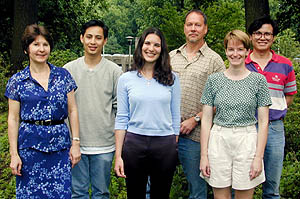| |
| |
| S. Brian Andrews, Ph.D., Senior Investigator |
 |
Dr. Andrews received his B.S. from Providence College and his Ph.D. in Chemistry from the Massachusetts Institute of Technology. Subsequently, he was trained in Cell Biology as a postdoctoral fellow at Yale University School of Medicine. He remained at Yale on the faculty of the Departments of Cell Biology and Physiology until 1983, during which time he developed an interest in ion transport and analytical electron microscopy. In 1983, he moved to NINDS to join Tom Reese's newly formed Laboratory of Neurobiology, rising to Section Chief in 1990. Dr. Andrews' research group is investigating calcium regulation of synaptic activity in neurons, a program for which analytical and structural microscopy continues to be important. The laboratory also maintains an active interest in emerging areas of biological electron microscopy, e.g., electron energy loss spectroscopy and cryoelectron microscopy.
|

|
Staff:

- Christine A. Brantner, Ph.D., Research Associate, (301) 435-2803 brantnec@ninds.nih.gov
- Jarin Hongpaisan, Ph.D., Adjunct Investigator, (301) 496-1173 hongpaij@brni-jhu.org
- Diane D. Murphy, Ph.D., (301) 496-5680 murphyd@ninds.nih.gov
- Natalia B. Pivovarova, Ph.D., Staff Scientist, (301) 435-2808 PivovarN@ninds.nih.gov
Research Interests:
Among recent advances in the field of calcium (Ca2+) signaling is the realization that mitochondrial and ER Ca2+ transport play critical roles in shaping the spatiotemporal characteristics of activity-evoked free Ca2+ transients. This Section investigates the basic physiology of this type of signal modulation, which in neurons is important for several physiological and pathophysiological processes, including gene transcription, synaptic plasticity, excitotoxicity, and neurodegeneration. Current studies focus on the mechanisms by which mitochondrial Ca2+ uptake mediates excitotoxic injury and regulates activity-dependent neuronal plasticity.
Advanced electron microscopy (EM) is among our most important tools; in this regard, the Section is well equipped to support its biological goals. Modern instruments are available -- either in-house or through longstanding collaborations with other NIH laboratories -- to support a variety of state-of-the-art EM techniques, including rapid freezing, electron probe x-ray microanalysis (EPMA), scanning transmission EM (STEM) mass mapping, electron energy loss spectroscopy (EELS), energy filtering (EFTEM), cryomicroscopy, and electron tomography. An application example that illustrates the capability of our instrumentation is a recent study (Hongpaisan et al, 2001) reporting the spatial mapping, at better than 20 nm resolution, of the transient mitochondrial Ca2+ gradients that are evoked by Ca2+ entry.
|
Selected Recent Publications:
Hongpaisan J, Winters, CA, Andrews SB (2004) Strong calcium entry activates mitochondrial superoxide generation, up-regulating kinase signaling in hippocampal neurons, J Neurosci 24, 10878-10887.
Full Text/Abstract
Pivovarova NB, Nguyen HV, Winters CA, Brantner, CA, Smith CL, Andrews SB (2004) Excitotoxic calcium overload in a subpopulation of mitochondria triggers delayed death in hippocampal neurons, J Neurosci 24, 5611-5622.
Full Text/Abstract
Hongpaisan J, Winters, CA, Andrews SB (2003) Calcium-dependent mitochondrial superoxide modulates nuclear CREB phosphorylation in hippocampal neurons, Mol Cell Neurosci 24, 1103-1115.
Full Text/Abstract
Pivovarova NB, Pozzo-Miller LD, Hongpaisan J, Andrews SB (2002) Correlated calcium uptake and release by mitochondria and ER of CA3 hippocampal dendrites following afferent synaptic stimulation, J Neurosci 22, 10653-10661.
Full Text/Abstract
Hongpaisan J, Pivovarova NB, Colegrove SL, Leapman RD, Friel DD, Andrews SB (2001) Multiple modes of Ca2+-induced Ca2+ release in sympathetic neurons II: A [Ca2+]i- and location-dependent transition from ER Ca accumulation to net Ca release, J Gen Physiol 118, 101-112.
Full Text/Abstract
All Selected Publications
Contact Information:
Dr. S. Brian Andrews
Analytical Cell Biology Section
Laboratory of Neurobiology, NINDS
Building 49, Room 3A62
49 Convent Drive
Bethesda, MD 20892-4477
Telephone: (301) 435-2796 (office),
(301) 496-1296 (laboratory),
(301) 480-1485 (fax)
Email: sba@helix.nih.gov
|
|















